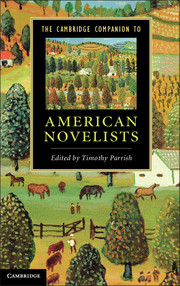Book contents
- Frontmatter
- Contents
- Contributors
- Introduction
- 1 James Fenimore Cooper
- 2 Nathaniel Hawthorne
- 3 Herman Melville
- 4 Harriet Beecher Stowe
- 5 Mark Twain
- 6 Henry James
- 7 Edith Wharton
- 8 Theodore Dreiser
- 9 Willa Cather
- 10 F. Scott Fitzgerald
- 11 Ernest Hemingway
- 12 William Faulkner
- 13 Henry Roth
- 14 Djuna Barnes
- 15 Zora Neale Hurston
- 16 Richard Wright
- 17 Raymond Chandler
- 18 Ralph Ellison
- 19 J. D. Salinger
- 20 Patricia Highsmith
- 21 Vladimir Nabokov
- 22 Jack Kerouac
- 23 Saul Bellow
- 24 Kurt Vonnegut
- 25 John Updike
- 26 Thomas Pynchon
- 27 Toni Morrison
- 28 Philip Roth
- 29 Don DeLillo
- 30 Cormac McCarthy
- Guide to Further Reading
- Index
- References
13 - Henry Roth
Published online by Cambridge University Press: 05 December 2012
- Frontmatter
- Contents
- Contributors
- Introduction
- 1 James Fenimore Cooper
- 2 Nathaniel Hawthorne
- 3 Herman Melville
- 4 Harriet Beecher Stowe
- 5 Mark Twain
- 6 Henry James
- 7 Edith Wharton
- 8 Theodore Dreiser
- 9 Willa Cather
- 10 F. Scott Fitzgerald
- 11 Ernest Hemingway
- 12 William Faulkner
- 13 Henry Roth
- 14 Djuna Barnes
- 15 Zora Neale Hurston
- 16 Richard Wright
- 17 Raymond Chandler
- 18 Ralph Ellison
- 19 J. D. Salinger
- 20 Patricia Highsmith
- 21 Vladimir Nabokov
- 22 Jack Kerouac
- 23 Saul Bellow
- 24 Kurt Vonnegut
- 25 John Updike
- 26 Thomas Pynchon
- 27 Toni Morrison
- 28 Philip Roth
- 29 Don DeLillo
- 30 Cormac McCarthy
- Guide to Further Reading
- Index
- References
Summary
“I – I’m losted,” sobs six-year-old David Shearl in Henry Roth’s (1906–95) novel Call It Sleep (1934), as a passerby on New York’s Lower East Side tries to help the quivering child, who cannot find his way back home. Although he can answer her question, “Don’t you know where you live?” with a specific address, this information is useless because neither she nor the policeman at the local precinct can discern the name of the street from his heavily accented English. David knows that he lives at “A hunner ‘n’ twenny six Boddeh Stritt” (99), which could be anything from Potter to Bahrdee, or as the Irish cop tells his mother when she arrives at the station, “I’m thinkin’ ye’d best put a tag on him, fer he sure had us up a tree with his Pother an’ Body an’ Powther!” (106). On the margins of the manuscript of Call It Sleep, Roth scribbled various ways of transcribing the sound of this unnamed street as voiced by a sobbing child, ending with “Body Street,” the mother’s body as the ultimate home that a six-year-old lost on the streets of New York would be seeking. Yet when his mother arrives at the station, we understand along with David that his mother is also lost, for this immigrant, whose conversations with her son prior to this scene convey her intelligence, sensitivity, and eloquence, can barely utter, “T’anks so viel!” (106). We suddenly grasp that up to this moment her speech has been rendered to us in a nuanced and lyrical English that has actually been a translation from an absent Yiddish original, in her mother tongue. Infantilized as an immigrant, Genya Shearl can no longer fully protect her own child in a world in which she herself cannot find her way.
- Type
- Chapter
- Information
- The Cambridge Companion to American Novelists , pp. 125 - 134Publisher: Cambridge University PressPrint publication year: 2012

